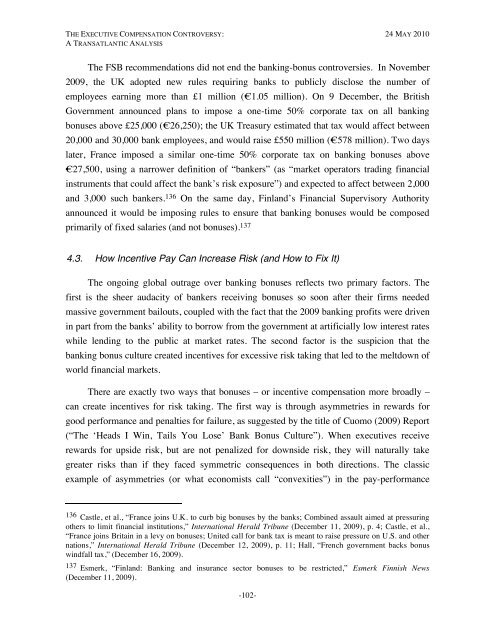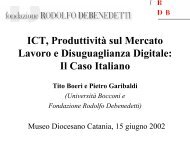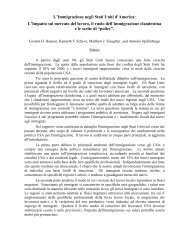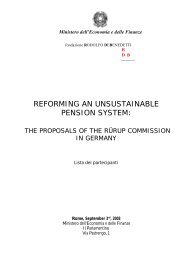The Executive Compensation Controversy - Fondazione Rodolfo ...
The Executive Compensation Controversy - Fondazione Rodolfo ...
The Executive Compensation Controversy - Fondazione Rodolfo ...
You also want an ePaper? Increase the reach of your titles
YUMPU automatically turns print PDFs into web optimized ePapers that Google loves.
THE EXECUTIVE COMPENSATION CONTROVERSY: 24 MAY 2010A TRANSATLANTIC ANALYSIS<strong>The</strong> FSB recommendations did not end the banking-bonus controversies. In November2009, the UK adopted new rules requiring banks to publicly disclose the number ofemployees earning more than £1 million (€1.05 million). On 9 December, the BritishGovernment announced plans to impose a one-time 50% corporate tax on all bankingbonuses above £25,000 (€26,250); the UK Treasury estimated that tax would affect between20,000 and 30,000 bank employees, and would raise £550 million (€578 million). Two dayslater, France imposed a similar one-time 50% corporate tax on banking bonuses above€27,500, using a narrower definition of “bankers” (as “market operators trading financialinstruments that could affect the bank’s risk exposure”) and expected to affect between 2,000and 3,000 such bankers. 136 On the same day, Finland’s Financial Supervisory Authorityannounced it would be imposing rules to ensure that banking bonuses would be composedprimarily of fixed salaries (and not bonuses). 1374.3. How Incentive Pay Can Increase Risk (and How to Fix It)<strong>The</strong> ongoing global outrage over banking bonuses reflects two primary factors. <strong>The</strong>first is the sheer audacity of bankers receiving bonuses so soon after their firms neededmassive government bailouts, coupled with the fact that the 2009 banking profits were drivenin part from the banks’ ability to borrow from the government at artificially low interest rateswhile lending to the public at market rates. <strong>The</strong> second factor is the suspicion that thebanking bonus culture created incentives for excessive risk taking that led to the meltdown ofworld financial markets.<strong>The</strong>re are exactly two ways that bonuses – or incentive compensation more broadly –can create incentives for risk taking. <strong>The</strong> first way is through asymmetries in rewards forgood performance and penalties for failure, as suggested by the title of Cuomo (2009) Report(“<strong>The</strong> ‘Heads I Win, Tails You Lose’ Bank Bonus Culture”). When executives receiverewards for upside risk, but are not penalized for downside risk, they will naturally takegreater risks than if they faced symmetric consequences in both directions. <strong>The</strong> classicexample of asymmetries (or what economists call “convexities”) in the pay-performance136 Castle, et al., “France joins U.K. to curb big bonuses by the banks; Combined assault aimed at pressuringothers to limit financial institutions,” International Herald Tribune (December 11, 2009), p. 4; Castle, et al.,“France joins Britain in a levy on bonuses; United call for bank tax is meant to raise pressure on U.S. and othernations,” International Herald Tribune (December 12, 2009), p. 11; Hall, “French government backs bonuswindfall tax,” (December 16, 2009).137 Esmerk, “Finland: Banking and insurance sector bonuses to be restricted,” Esmerk Finnish News(December 11, 2009).-102-









